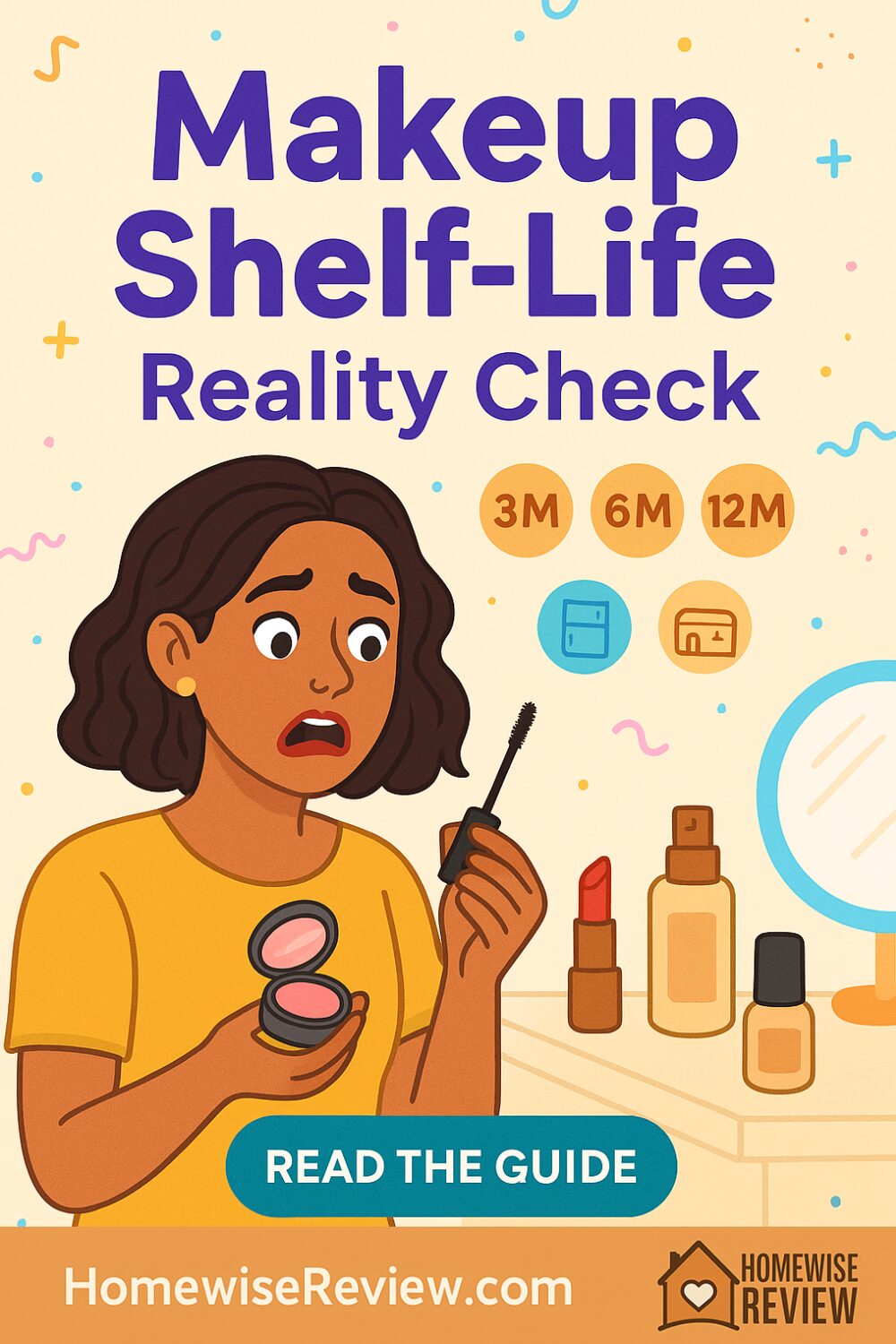
Most makeup has a “use-by” period after you open it, even if it’s unlabeled. Generally liquid eye products spoil fastest because each use introduces bacteria by the applicator, posing a risk of eye infections. For example, mascara and liquid eyeliner should be replaced roughly every 3–6 months fda.gov. (FDA experts note manufacturers advise tossing mascara after ~2–4 months) Cream or water-based products (like liquid concealers or creams) come next – they typically last about 6–12 months once opened paulaschoice.sg. In contrast, dry powders (eyeshadow, blush, pressed powders) stay good longest – often up to 1–2 years or more lorealparisusa.com.
- Fastest to expire: Mascara, liquid eyeliners, liquid foundations/concealers. These are high-moisture formulas used around eyes or skin, so bacteria accumulate and preservatives break down.
- Medium shelf life: Cream products (cream eyeshadow, cream blush) and pencil eyeliners. Typically ~1–1.5 years. Creams can dry out or go rancid after about a year lorealparisusa.com, and pencil liners have more longevity (often ~1–2 years) than liquids byrdie.com.
- Longest shelf life: Powder makeup (eyeshadows, blushes, bronzers, powder foundation) can last 1–2 years or more because dry formulas don’t harbor bacteria easily.
Typical Shelf Life of Common Makeup
Below are rough guidelines for how long to keep products after opening:
- Mascara: ~3–6 months. (Discard if it dries out.)
- Liquid eyeliner: ~3–6 months. (Gel liners: ~6–12 months; pencil liners: ~1–2 years.)
- Powder eyeshadow: ~1–2 years. (Replace within about a year, especially if it’s used on the eyes.)
- Cream eyeshadow/blush: ~12–18 months.
- Foundation (liquid): ~6–12 months. (Water-based foundations spoil faster; oil-based ones can last toward 12+ months.)
- Powder products (blush, bronzer, powder foundation): ~1–2 years.
- Lipstick/gloss/liner: ~1–2 years. (At most 2 years; many replace around 12 months.)
These ranges can vary by formula and brand, but manufacturers test stability and put a Period-After-Opening (PAO) code on the package (a little jar icon with “M” for months). For example, “6M” means 6 months after opening. Check that and, when in doubt, follow the shorter timeline for your safety and product performance.
Signs Your Makeup Has Expired
Watch (and sniff) for warning signs. If a product smells off or rancid, it’s time to toss it. Also look for texture or color changes: an old foundation may separate or become clumpy, creams can dry out or get cakey, and a lipstick that’s turned hard or crumbly (or changed shade) has likely oxidized. Powders may cake up or leave residue on the lid. Any unusual irritation, redness or eye discomfort after application is a clue a product is past its prime. In short, if a product looks or smells different (off-color, grainy, runny/drippy, or gives you a rash), play it safe and discard it.
Storing Makeup to Make It Last
Proper storage can stretch a product’s life. Keep cosmetics in a cool, dry, dark place – not steamy bathrooms or hot cars. One expert suggests storing makeup in a dresser or vanity drawer, ideally in its original box, to shield it from light and air . Always tighten caps and lids after use, and avoid double-dipping or touching applicators with fingers (to limit bacteria transfer). Clean brushes and sponges regularly (once a week or two) to prevent product buildup. Tip: Don’t pump the mascara wand in and out of the tube (that just adds air and dries the formula). When your products are tucked safely away, they’ll stay fresh longer.
- Store makeup on a dresser or in a cabinet – not in direct sunlight or near a heat source.
- Keep original packaging or boxes if possible, to block air and light exposure.
- Cap products tightly and wipe container rims clean after use to prevent mold or clumps.
- Sanitize brushes/tools regularly; change applicators (like sponge tip gloss wands) if they look grimy.
- Replace tubes and pencils by their PAO date or at first sign of odd smell/texture.
Cold Storage: To Fridge or Not?
Is a beauty fridge a must? Most experts say you don’t have to refrigerate makeup, and it can even harm some formulas. A practical guideline is that cosmetics are usually formulated to be stored at room temperature. In fact, one skincare brand (Paula’s Choice) warns that long-term refrigeration can shorten product stability, with a few exceptions like pure vitamin C serums. On the flip side, some chefs of beauty recommend keeping rarely-used lipsticks or natural balms in a cool place to slow degradation. In practice, a closet or drawer at home temperature (about 65–75°F) is fine for almost all makeup. If you do use a mini-fridge, avoid storing products in the main kitchen fridge (its humidity and cold could cause condensation and ruin the texture).
In summary: Cool storage is good, but extreme cold isn’t necessary. Storing lipsticks or serums in a beauty fridge may help a bit (Real Simple suggests it), but generally avoid putting most makeup in the regular refrigerator, as it may shorten shelf life. Keep it in a stable, moderate climate instead.
The little open-jar icon is the PAO (Period-After-Opening) symbol. A number on the icon (e.g. 3M, 6M, 12M) tells you how many months a product is safe to use after opening.
- 3M (3 months): Often used for mascaras and liquid eyeliners. (Discard by 3 months after you first open it.)
- 6M (6 months): Common on foundations, concealers, and cream products. Use within 6 months of opening.
- 12M (12 months): Typical for lipsticks, lip glosses, and creams. One year after opening.
- 24M (24 months): Seen on powders and very stable, dry products (2 years).
Always check that jar-and-M symbol on new purchases and note it. You can also write the opening date on the package to remember when that period is up.
Makeup Shelf Life at a Glance
| Product Type | After-Opening Shelf Life |
|---|---|
| Mascara | ~3–6 months |
| Liquid eyeliner | ~3–6 months |
| Pencil eyeliner/brows | ~12–24 months |
| Liquid foundation/concealer | ~6–12 months |
| Powder foundation, blush, bronzer | ~1–2 years |
| Eyeshadow (powder) | ~1–2 years |
| Cream blush/cream eyeshadow | ~12–18 months |
| Lipstick/Lip gloss/Lip liner | ~1–2 years |
| (Extra tip: Nail polish lasts ~1 year after opening.) |
These are general guidelines – for safety and best results, stick to the shorter end of each range if you can. Toss any item that’s gotten funky, and enjoy fresh makeup without worry!
Sources: Authoritative beauty and health guides and experts (FDA, Real Simple, L’Oréal Paris, Paula’s Choice, Byrdie, MasterClass)
Each recommendation above comes from these trusted references.
See Also:
If you’re tweaking your base routine, start with the right foundation for your skin type. Compare formulas in our Best Foundation for Oily Skin and Best Foundation for Dry Skin guides, then adjust textures and techniques with How to Adjust Your Makeup in Winter.
To lock everything in without cakiness, check our wear-test picks in Best Setting Sprays for All-Day Makeup. If your eyes are easily irritated or watery, swap in gentler formulas from Best Mascara for Sensitive Eyes.
